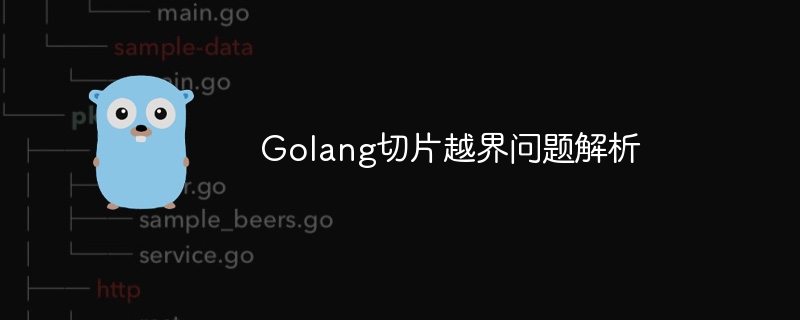

Golang slice cross-border problem analysis
Golang is an efficient and concise programming language. As an important data structure, slices are used in daily life. Often used in development. However, when using slices, we often encounter slice out-of-bounds problems. This article will analyze in detail the causes of out-of-bounds slicing problems in Golang and how to avoid such problems, and provide specific code examples to illustrate.
In Golang, a slice is a reference to an array, which contains three pieces of information: a pointer to the array, the length of the slice, and the capacity of the slice. A slice can grow in length dynamically without declaring its size in advance. The basic definition form of a slice is as follows:
var slice []int // Define an initially empty integer slice
Slices can be created through the make function, also You can use slice literals directly. For example:
// Use the make function to create a slice
slice := make([]int, 0, 10) // Create an integer slice with an initial length of 0 and a capacity of 10
//Create slices using slice literals
slice := []int{1, 2, 3, 4, 5} // Create a slice containing 5 integer elementsOut-of-bounds access of slice refers to when An error occurs when accessing an index position that does not exist in the slice. Accessing a slice out of bounds can cause the program to crash or produce unexpected results. For example, accessing an index position that exceeds the slice length:
package main
import "fmt"
func main() {
slice := []int{1, 2, 3, 4, 5}
fmt.Println(slice[5]) // Attempt to access the 6th element, exceeding the slice length
}The above code will cause a panic error because a non-existent index location is accessed. In order to avoid slice out-of-bounds access problems, we can check the index range before accessing the slice. For example:
package main
import "fmt"
func main() {
slice := []int{1, 2, 3, 4, 5}
index := 5
if index >= 0 && index < len(slice) {
fmt.Println(slice[index])
} else {
fmt.Println("Index out of range")
}
}By checking the index range, we can avoid the problem of out-of-bounds access to slices.
In Golang, when a slice is expanded, a new array will be generated and the elements in the original array will be copied to the new array. When the length of a slice exceeds its capacity, the slice will be expanded and the capacity will increase accordingly. The expansion of slices follows a certain strategy, usually to double the original capacity. This is also a reason for the slice out-of-bounds problem, because when expanding, the old index may exceed the length of the new slice. For example:
package main
import "fmt"
func main() {
slice := make([]int, 3, 3)
fmt.Println("Slice:", slice)
slice = append(slice, 4)
fmt.Println("Slice after append:", slice)
fmt.Println("Element at index 4:", slice[4]) // Access an index beyond the slice length
}In the above code, we performed an append operation on a slice with a length of 3 and a capacity of 3. At this time, the expansion of the slice will be triggered and the capacity of the slice will be expanded to 6. However, because the length of the original slice is 3, the element at index 4 does not exist, and accessing this index position will cause a panic error.
In order to avoid slicing out-of-bounds problems, we can take the following methods:
copy function, append function, etc. to avoid manual processing that may lead to out-of-bounds operations. In short, when using slicing, be sure to pay attention to the range of the index to avoid the problem of out-of-bounds access to the slicing and ensure the stability and reliability of the code.
Through the introduction of the above content, I believe that readers will have a deeper understanding of the out-of-bounds access problem of slices in Golang and learn how to avoid such problems. I hope this article is helpful to you, thank you for reading!
The above is the detailed content of Golang slice cross-border problem analysis. For more information, please follow other related articles on the PHP Chinese website!
 How to define variables in golang
How to define variables in golang
 What are the data conversion methods in golang?
What are the data conversion methods in golang?
 What are the commonly used libraries in golang?
What are the commonly used libraries in golang?
 What is the difference between golang and python
What is the difference between golang and python
 sublime runs js code
sublime runs js code
 The difference between MATE60 and MATE60PRO
The difference between MATE60 and MATE60PRO
 How to solve the problem that the folder does not have security options
How to solve the problem that the folder does not have security options
 securefx cannot connect
securefx cannot connect
 java
java




